Tohoku Future Leaders Summit 2011
2012.05.19
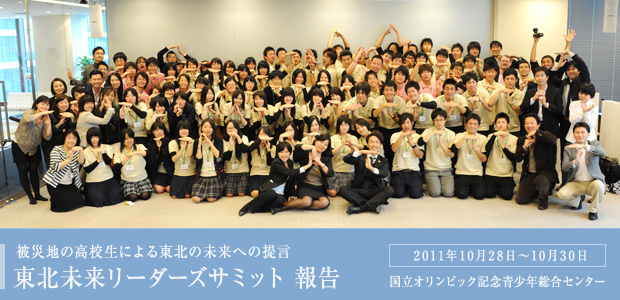
Video Highlights
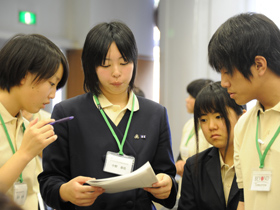 The summit was established to target young people who were victims of the Tohoku earthquake and tsunami but have strong ambitions to overcome their challenges and become active citizens with a global perspective. The students created a proposal for the recovery of the Tohoku region, working in groups with support from advisors, a select group of professionals who are leaders in their respective fields. Each student group presented its proposal to an audience of leaders from areas such as politics, business administration, media, and NGOs. Furthermore, as the summit spanned multiple days, the students had the opportunity to discuss and explore career goals with invited experts from fields such as sports, music and arts. The goal of this summit was to offer a starting point for the student participants to fully realize their potential as influential citizens who can shape society. BEYOND Tomorrow strongly believes that because of their difficult experiences during the disaster, these students have a unique ability to empathize and identify with others, and we hope that with this summit they were able to reflect on how they can use this ability to fill an active role in society and how to convert these ideas into actions.
The summit was established to target young people who were victims of the Tohoku earthquake and tsunami but have strong ambitions to overcome their challenges and become active citizens with a global perspective. The students created a proposal for the recovery of the Tohoku region, working in groups with support from advisors, a select group of professionals who are leaders in their respective fields. Each student group presented its proposal to an audience of leaders from areas such as politics, business administration, media, and NGOs. Furthermore, as the summit spanned multiple days, the students had the opportunity to discuss and explore career goals with invited experts from fields such as sports, music and arts. The goal of this summit was to offer a starting point for the student participants to fully realize their potential as influential citizens who can shape society. BEYOND Tomorrow strongly believes that because of their difficult experiences during the disaster, these students have a unique ability to empathize and identify with others, and we hope that with this summit they were able to reflect on how they can use this ability to fill an active role in society and how to convert these ideas into actions.
Create a proposal
- Topic A:Reviving industry – how to revitalize Tohoku through business and work
- Topic B:Disaster prevention – building a safe city
- Topic C:Victim Support
In the morning of Day 2, the students were asked to develop plans for Tohoku’s future.
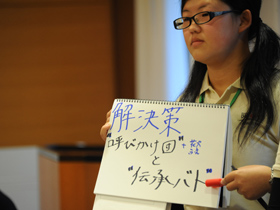 “Suppose you are formally acknowledged by Minister Furukawa, the Minister of National Strategy, as members of the Tohoku Revival teams. The mission of the teams is to create tangible project proposals that would help revive the Tohoku region, following the devastating effects of the Great East Japan Earthquake. In teams you have to meet the objective of creating proposals that could realistically be achieved, with the expectation that team members would commit to the management of the projects for a full year. ”
“Suppose you are formally acknowledged by Minister Furukawa, the Minister of National Strategy, as members of the Tohoku Revival teams. The mission of the teams is to create tangible project proposals that would help revive the Tohoku region, following the devastating effects of the Great East Japan Earthquake. In teams you have to meet the objective of creating proposals that could realistically be achieved, with the expectation that team members would commit to the management of the projects for a full year. ”
Three different themes were outlined for the projects: Tohoku revitalization, disaster prevention and victim support. Each team created proposals based on the category to which they were assigned.
-
- Revitalizing the work and business industries of Tohoku. Teams assigned to this category were encouraged to identify the business sectors that have been struggling. Based on what they determined, teams went on to create business proposals that would bring life and energy back into the region and establish Tohoku as an entrepreneurial hub.
-
- Disaster Prevention Teams created proposals that would help the local populace of Tohoku feel more secure, by considering what safety measures could be implemented in order to minimize the damaging effects of potential tsunamis and earthquakes.
-
- Victim support For this category teams deliberated over what sort of aid and support the victims of the Great East Japan Earthquake needed, or benefited from, the most. Their proposals envisioned plans that would provide the most effective aid to all victims, whilst considering the fact that the specific needs for individuals would undoubtedly vary.
The united voice of the people of Tohoku
- Whilst the people of Tohoku are extremely grateful for the compassionate efforts of the volunteers, they maintain that volunteering is not always synonymous with being helpful; really effective volunteering comes from volunteers being thoughtful about what the real needs of the victims are. For example, hair dressers who lost their entire businesses and tools to the earthquake disaster could not fully appreciate the work of those volunteers who offered hair-dressing services to victims. For the local hairdressers, those volunteers inevitably became competitors who had an unfair advantage over them because they had tools.
- During the disaster mobile phones and electronic bulletin boards stopped working all together, and it was impossible for people to get in touch with family members in order ascertain their well-being. Having experienced this, people now realise the extreme importance of having alternative ways to re-group and get in touch with one another, in the event of another disaster.
- Although temporary housing has been constructed, they are not long-term solutions to the problem of housing. Problems with regards to employment, food and the even distribution of aid are outstanding as well.
- Tohoku desperately needs to develop an environment that encourages the youth to return. The establishment of employment opportunities and better hospitals also needs to be on the agenda. Furthermore, the maintenance of social ties amongst the population of Tohoku and a sense of community ought to be a high priority.
- There are many rumors that address the danger of products from areas close to the nuclear power plant. As a result, fruits are returned, and people are damaging cars with license plates from Fukushima. Something must be done immediately to solve this issue.
- With too many differing views and a lack of cohesive communication amongst the victims, decisive action and leadership are vital at this point.
- Too many people are becoming passive about organization, so public discourse and the amalgamation of ideas ought to take place. Furthermore, the problem of youth leaving Tohoku would be best addressed by the youth themselves.
- Many people find it difficult to think of strategies to revive Tohoku in the long-term, since short-term goals have not been outlined.
- The region needs to focus on building a safe and barrier free environment, particularly for the physically disabled. Furthermore, awareness and pre-emptive preparations regarding potential tsunamis and earthquakes must be raised.
Interview with experts on Tohoku revitalization
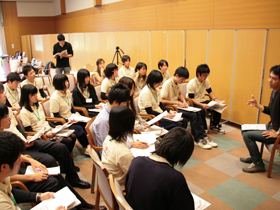 Having the chance to talk with some of the leading experts on reviving Tohoku, professionals with real-world experiences in reconstructing all relevant sectors, was a wonderful opportunity for the students to expand their perspective and develop realistic project plans.
Each team questioned and interviewed experts from the categories to which they were assigned. With the most pertinent knowledge and skills to share, the professionals responded to the enthusiastic questions and helped the students envision their plans both realistically and effectively. They differentiated the necessary from the unhelpful, the doable from the futile, with articulate and encouraging support.
Having the chance to talk with some of the leading experts on reviving Tohoku, professionals with real-world experiences in reconstructing all relevant sectors, was a wonderful opportunity for the students to expand their perspective and develop realistic project plans.
Each team questioned and interviewed experts from the categories to which they were assigned. With the most pertinent knowledge and skills to share, the professionals responded to the enthusiastic questions and helped the students envision their plans both realistically and effectively. They differentiated the necessary from the unhelpful, the doable from the futile, with articulate and encouraging support.
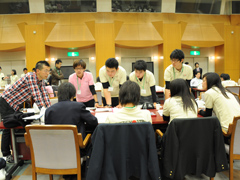 It was invigorating to see the eager and looks on all of the students faces, as they all tried to fit in one more question and develop a deeper understanding of the situation and their projects. Even after the interview session was over, the students mingled around the professionals, waiting to hear what else they could learn.
It was invigorating to see the eager and looks on all of the students faces, as they all tried to fit in one more question and develop a deeper understanding of the situation and their projects. Even after the interview session was over, the students mingled around the professionals, waiting to hear what else they could learn.
TopicA Reviving industry – how to revitalize Tohoku through business and work
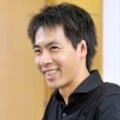 Retsu Fujisawa
Chief Director, General Incorporated Association RCF Reconstruction Support Team
A graduate of Hitotsubashi University, Fujisawa had significant experience working for McKinsey & Company before going on to independently consult for ventures and entrepreneurs. Immediately following the earthquake disaster, he initiated a project that connected victims with NPOs. He gathered data from 400 refuge centers within the Miyagi prefecture, in order to collaborate with the local NPOs and the media. He has founded the revival assistance team and works on related administration and education projects for the victims. Since March 2011, he has also been assigned a position as a member of government headquarters for monitoring NPO aid and relief.
Retsu Fujisawa
Chief Director, General Incorporated Association RCF Reconstruction Support Team
A graduate of Hitotsubashi University, Fujisawa had significant experience working for McKinsey & Company before going on to independently consult for ventures and entrepreneurs. Immediately following the earthquake disaster, he initiated a project that connected victims with NPOs. He gathered data from 400 refuge centers within the Miyagi prefecture, in order to collaborate with the local NPOs and the media. He has founded the revival assistance team and works on related administration and education projects for the victims. Since March 2011, he has also been assigned a position as a member of government headquarters for monitoring NPO aid and relief.
Students Notes:
- Following the establishment of temporary housing in May, in order to approach the matter of rebuilding the livelihoods of the victims, a network amongst the victims and reconstruction teams must be powered and an appeal to the local governing body presented.
- With the assistance of financial aid for the purpose of rebuilding, a special focus needs to be made on the fishing industry, particularly with regards to repairing and building boats and other fishing facilities.
- For revitalization to take place in the most innovative and effective manner, projects must address the people of Tohoku and the needs of the region as a whole. The voices of civilians are the best sources of information, and they must be the central focus. Furthermore, issues must be approached with long-term solutions on top of short-term activities.
Students Notes:
- Q: How should we overcome the effects of rumours and prejudices? A: As opposed to focusing solely on how to overcome rumours, you must think in terms of the big picture; think about ways to shed positive light on Japan and its prefectures. Q: We realise that strong leadership is needed in order to rebuild and revitalize Tohoku, but what are your thoughts on youths as leaders? A: I would like the youth to maintain a clear distinction between a “manager” and a “leader.” A manager faces you and gives you instructions. Leaders turn their backs towards you and start walking forward. You are encouraged to follow them because they have conviction in what they are doing and are not afraid to take the first, bold step forward.
Topic B Disaster prevention – building a safe city
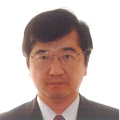 Satoru Nishikawa
Director of Land and Real Property Market Division, MLIT Japan
Originally from Kanagawa prefecture, Nishikawa graduated from the department of engineering in Tokyo University and completed his Master’s degree before entering the Japanese Land Agency. Working on projects centering on land development, he also focused his skills on developing the metropolis of Nagoya before accepting a position as a guest researcher at MIT. In 1989 he began work on developing disaster prevention enterprises and disaster prevention in foreign countries, as a representative of the Japanese Land Agency. Between 1992 and 1995, he served as the head of emergency aid operations for the U.N. Upon his return to Japan, he worked on various projects that included long term planning for Japan’s water resources and the reshuffling of the central government offices of Japan. Following this he became the head of the center of disaster prevention for Asia, and official councillor on disaster prevention for the cabinet during the earthquake disaster of Niigata Prefecture in 2004, and the Indian Ocean Earthquake and Tsunami. In 2005 he organized the UN disaster prevention global conference and as a professor of engineering, he has also been an active participant in the World Economic Forum.
Satoru Nishikawa
Director of Land and Real Property Market Division, MLIT Japan
Originally from Kanagawa prefecture, Nishikawa graduated from the department of engineering in Tokyo University and completed his Master’s degree before entering the Japanese Land Agency. Working on projects centering on land development, he also focused his skills on developing the metropolis of Nagoya before accepting a position as a guest researcher at MIT. In 1989 he began work on developing disaster prevention enterprises and disaster prevention in foreign countries, as a representative of the Japanese Land Agency. Between 1992 and 1995, he served as the head of emergency aid operations for the U.N. Upon his return to Japan, he worked on various projects that included long term planning for Japan’s water resources and the reshuffling of the central government offices of Japan. Following this he became the head of the center of disaster prevention for Asia, and official councillor on disaster prevention for the cabinet during the earthquake disaster of Niigata Prefecture in 2004, and the Indian Ocean Earthquake and Tsunami. In 2005 he organized the UN disaster prevention global conference and as a professor of engineering, he has also been an active participant in the World Economic Forum.
Students’ Notes:
- Disaster prevention can be effectively achieved through the collaboration between humanity and nature. The weaker a society is in facing unpredictable natural phenomena, the greater the risk of damage from natural disasters.
- Japan has a high occurrence of earthquakes relative to the rest of the world. After the damaging effects of the Isewan Typhoon, post-war Japan began investing in disaster prevention measure, which has been helpful to this day.
- It is very important to study maps carefully and appreciate the descriptive names that our ancestors left for us, which reveal the characteristics of terrains.
Students’ Notes:
- Q: What is safety and security? A: The answer varies depending on whose safety you are taking into consideration. Always clearly identify whose safety you are targeting first and foremost; thereafter, in order to implement effective safety measures, you must differentiate between measures that will cost money and those which will not. Q: Since the media has failed to honestly report the sentiments and issues of the local civilians, what can be done to change this? A: Indeed, the government and other establishments of authority do have the tendency to control what is distributed via the media. In light of this, it is important for the public to take action and voice their sentiments which they feel are not adequately expressed.
Topic C Victim Support
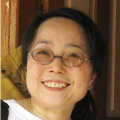 Miyako Hamasaka
JEN Manager, External Relations
Originally from Kyoto, Ms. Hamazaka worked for three years in the entrepreneurial sector before moving to Singapore and establishing her own public relations firm. She returned to Tokyo in 2006 and joined JEN, Inc. as a public relations manager. In 2007 she headed the public relations for a team that worked on reviving Niigata, and following that she went to Pakistan to head a video research project. In 2009 she entered her current position to head public and media relations. Immediately following the earthquake disaster in March, she headed a program that distributed aid material to victims. During the months of March and April, she was responsible for the successful execution of projects in Ishinomaki, particularly with regards to the distribution of aid.
Miyako Hamasaka
JEN Manager, External Relations
Originally from Kyoto, Ms. Hamazaka worked for three years in the entrepreneurial sector before moving to Singapore and establishing her own public relations firm. She returned to Tokyo in 2006 and joined JEN, Inc. as a public relations manager. In 2007 she headed the public relations for a team that worked on reviving Niigata, and following that she went to Pakistan to head a video research project. In 2009 she entered her current position to head public and media relations. Immediately following the earthquake disaster in March, she headed a program that distributed aid material to victims. During the months of March and April, she was responsible for the successful execution of projects in Ishinomaki, particularly with regards to the distribution of aid.
Students’ Notes:
- Q: How do you rank types of aid, in order of importance?
- A:
- This question is an extremely important one to ask and, at the same time, it is also a difficult one to provide answers to. What is vital is to avoid providing redundant aid, however, there are times when the provision of aid doesn’t go as well as one would like.
- Since it is very difficult to attain specific, minute details, as a general rule of thumb, you should avoid distributing aid outside of refuge centres or large meeting spots.
- Since the damages are generally so large, it is very difficult for aid to function efficiently from the top down. NGOs also struggle to maintain accurate communication with the whole picture. As a result, a good structure would be to have NGOs functioning as the communication link between the government and victims.
Comments from the lecturer
“Taking heed of the fact that my audience were high school students, I removed a few slides from my original presentation. I was pleasantly shocked to find that during the Q/A session, the students proceeded to address all the contents on the slides that I had removed. They were all extremely sharp and held impressive opinions. It really made me realise that these students, having experienced the damaging effects first hand, have an incredible capacity to consider what Tohoku needs and how to revitalize their home region. I am so excited to see what proposals they will create as a result.”Final presentations
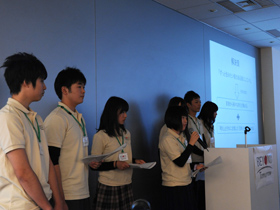 70 students built a strong community with one another, shared ideas and worked as teams for challenging three days. Drawing on their own experiences, whilst tirelessly representing the voices of so many, they endeavoured to listen to the advice of experts and create proposals that would envision a strong future for the Tohoku region. What the students finally presented at the end of the weekend impressed and astounded us all.
Each team had four minutes to present their proposals formally to the audience and a panel of judges. Two teams were respectively awarded the “Grade A” prize and a prize for excellence, for having the most impressively thought-out and structured proposals and presentations. The slides from team 10’s presentation, the winner for the Grade A prize, have been included here.
All team proposals will be presented to Minister of National Strategy Furukawa as suggestions for what can be initiated in Tohoku.
70 students built a strong community with one another, shared ideas and worked as teams for challenging three days. Drawing on their own experiences, whilst tirelessly representing the voices of so many, they endeavoured to listen to the advice of experts and create proposals that would envision a strong future for the Tohoku region. What the students finally presented at the end of the weekend impressed and astounded us all.
Each team had four minutes to present their proposals formally to the audience and a panel of judges. Two teams were respectively awarded the “Grade A” prize and a prize for excellence, for having the most impressively thought-out and structured proposals and presentations. The slides from team 10’s presentation, the winner for the Grade A prize, have been included here.
All team proposals will be presented to Minister of National Strategy Furukawa as suggestions for what can be initiated in Tohoku.
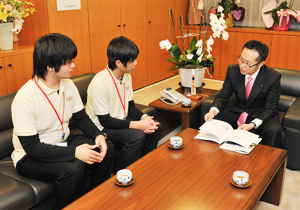
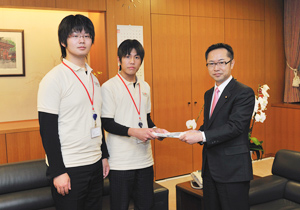
Survivors’ Stories
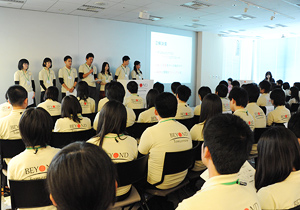 What actually happened on the 11th March 2011? As the time for the sharing of experiences began and the participating students listened intently to each other’s stories, the atmosphere of the room dramatically changed. Everyone squeezed out their words with great sincerity, and they were taken very seriously. Hearing other perspectives that many realized they hadn’t even imagined until now, tears were shed over the experiences of their peers.
It was as if one could hear the switch being flipped on in every single person. On the first day, expressions, actions and attitudes that were almost unimaginable all completely naturally materialized. Each individual’s story, and the bonds that were created through spending this time together, became the foundation and the start for this three day program.
What actually happened on the 11th March 2011? As the time for the sharing of experiences began and the participating students listened intently to each other’s stories, the atmosphere of the room dramatically changed. Everyone squeezed out their words with great sincerity, and they were taken very seriously. Hearing other perspectives that many realized they hadn’t even imagined until now, tears were shed over the experiences of their peers.
It was as if one could hear the switch being flipped on in every single person. On the first day, expressions, actions and attitudes that were almost unimaginable all completely naturally materialized. Each individual’s story, and the bonds that were created through spending this time together, became the foundation and the start for this three day program.
Speech content is displayed when you click a photo
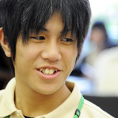

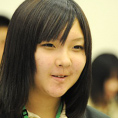


Media Coverage
| TV | 「NEWS23Cross」(2011/11/11 TBS) |
|---|---|
| News Papers | “Proposed recovery of Tohoku Recruiting high school students in 3 prefectures” (2011/10/12 Yomiuri Newspapers) |
| “Tohoku teens share views of survival”(2011/11/10 JAPAN TIMES) | |
| “Tohoku teens search recovery of Tohoku” (2011/10/10 The Kahoku Shimpo) | |
| ”Application for a meeting of future leaders in Tohoku “(2011/10/10 Iwate Nippo) | |
| “Application for high school students” (2011/10/12 Sanriku Sinpo) | |
| ” Meeting of future leaders in Tohoku Application for participants till 14″ (2011/10/12 Iwaki Minpo) | |
| ”Application for high school students who want to share Tohoku earthquake”(2011/10/13 Fukushima Minyu) | |
| WEB | “Leadership Development Business”Tohoku Future Leaders Summit” will be held on” (2011/10/14 LOVE&HOPE~human・care・project~) |
| “Support information:Scholar ship”(2011/10/03 Mainichi.jp(Mainichi Newspapers)) |
The success of the event would not have been possible without cooperation of a number of organizations and individuals
| Supporters | Cabinet Office Ministry of Education,Culture,Sports,Science and Technology |
|---|---|
| Message from prefectural governors | Fukushima Prefecture Iwate Prefecture Miyagi Prefecture |
| Partner | The Fund for the Future of Children affected by the Great East Japan Earthquake |
| Sponsors | CLSA FedEx Kinko’s Japan Gulliver International Co.,Ltd Mitsubushi Heavy Industries,Ltd、 ROHTO Pharmaceutical Co.Ltd Takeda Pharmaceutical Company Limited |
| Film Production | Kobe Design University infoGuild |
| Design | Ayako Nakagawa |

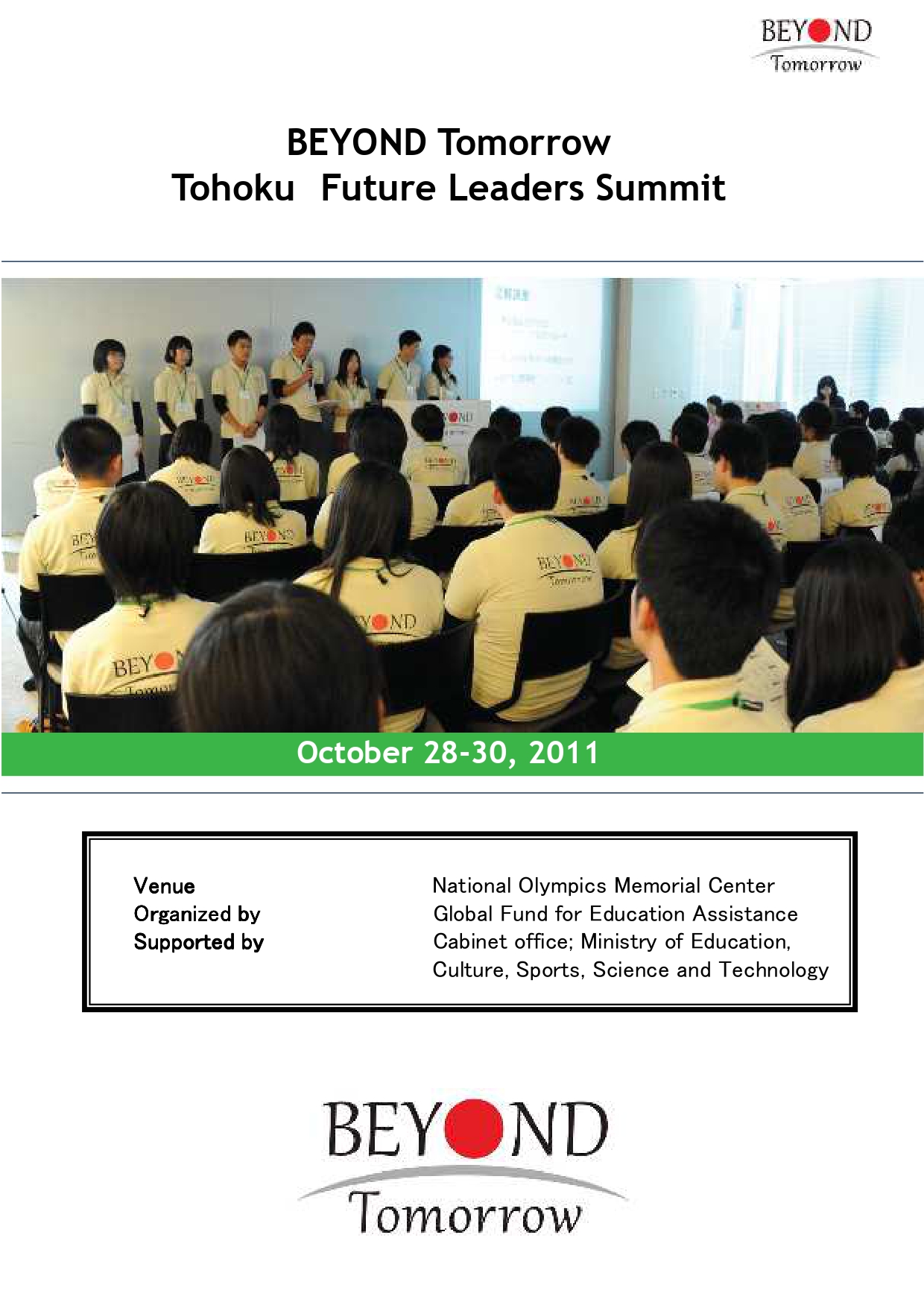 Download a full report
Download a full report